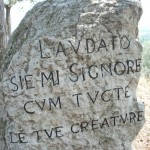“Tell everybody that God gives His graces through the Immaculate Heart of Mary. Tell them to ask graces from her, . . . for the Lord has confided the peace of the world to her.” ~ A message from the Lady of Fatima, according to Lucia Tomorrow is the optional Memorial of Our Lady of Fatima, the 99th anniversary of the Lady’s first appearance to three children minding their sheep in a bowl-like vale on a dusty Portuguese afternoon. The children,... Read more
















